Talk Session
EGAKU Exhibition: Opening Talk Session
What the EGAKU Program Gives
From children to business professionals – EGAKU Program has continued to expand its reach.
On July 1, 2014 we held a special talk event for the opening of the EGAKU Exhibition – an exhibition of works by veterans of the EGAKU Program.
“Why are business people today taking up painting?” “What’s the relationship between business and art?” Jun Nakahara – a researcher in the field of adult learning, and organizational development – opened up the discussion, followed by three guest speakers who each shared their experiences, and perspectives on what the EGAKU Program has given them.
“The unlikely relationship between innovation and art” “The possibilities within art to create learning experiences which dynamically nurture the creativity of individuals and organizations,” these were some of the issues discussed in this thought provoking talk session.

Introduction
"What Organizations Need Right Now is a Tolerance for Purposelessness
and a Tolerance for Low Visibility"
Jun Nakahara (Associate Professor for Management Learning, The University of Tokyo)

Talk 1
Having the Courage to Step Out
of Your Comfort Zone
Mitsunobu Koshiba (President
& Representative Director, JSR Corporation)

Talk 2
Shifting from Top-Down
Thinking to Bottom-Up Thinking
Akio Yajima (Senior Fellow,
The Japan Science and Technology Agency)

Talk 3
Shifting from "Carrying our their Roles" to "Acting Autonomously"
Miho Kawasaki (Organization Learning Consultant, Globis Corporation)

Concluding Remarks
The Three Unsettling Effects of Art Hold the Key to Growth
Jun Nakahara (Associate Professor for
Management Learning, The University of Tokyo)
Introduction
What Organizations Need Right Now is a Tolerance for Purposelessness and a Tolerance for Low Visibility
Jun Nakahara (Associate Professor for Management Learning, The University of Tokyo)
Talk moderator, Jun Nakahara, opened the talk session with the question: “So, what exactly am I - a researcher specializing in management theory and professional development, learning, and leadership within corporates - doing here?”
Nakahara came across the EGAKU Program through a web search, and decided to sign up for one of the sessions. One of the things that fascinated him most was being able to experience viscerally, “the process of giving meaning to the thoughts that arise from your inner consciousness - the process of meaning-making.” When initially approached to moderate the talk, despite his concerns about finding the time he decided to take up the offer out of sheer curiosity as to who would turn up to the talk.
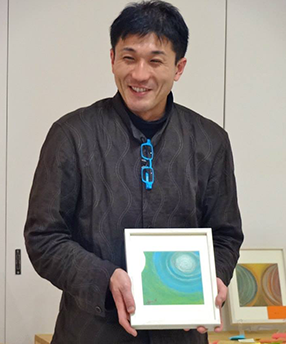
Why did I Participate in EGAKU in the first place? 3 Reasons:
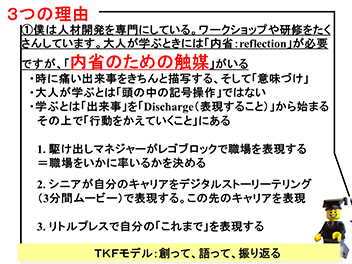
Reason 1) A Vehicle for Internal Reflection
“Reflection” is key to the learning experience for adults – but the reality is that even if you ask people to reflect on their own, they really struggle. Basically, they need a “vehicle for reflection.”
In the course of my research, I’ve organized many training programs, and have extensive experience creating learning experiences using a variety of mediums. For example, using Lego to improve the decision-making process of fledgling managers on the ground, getting senior citizens to think about their future careers through digital story telling (3 minute movie), using Little Place (a collage tool) to express who you are, and what you’ve done. So it’s within this context that I was particularly interested in the idea of painting with pastels.

Reason 2) What Organizations Need Right Now is “Tolerance for Purposelessness ≒ Tolerance for Low Visibility”!
Recently one thing I’ve been feeling increasingly in my research is the need for “tolerance for purposelessness” “tolerance for low visibility”. Universities are myopically focused on what’s immediately in front of them and can’t tolerate things that appear to be without purpose.
In researching innovation, you realize that although there are lots of good ideas out there, it’s often the case that the value hasn’t been realized. To create an organization that innovates continuously, I think you need a few things: a corporate culture that is accepting of things that have low visibility, which doesn’t suppress good ideas, and human relationships that allow for mutual appreciation.
In the midst of all this, art at first appears to be both “purposeless” and “low visibility.” I believe that by deploying art in organizations you might just be able to develop this “tolerance for purposelessness.” Innovation takes 15, 20 years, so if you’re making a fuss about painting a picture, then you’re a long way off from innovating. I also thought that it had the potential to become a vehicle to build relationships of mutual respect, to push us to create and discover new meanings.

Reason 3) The Increasing Importance of “Management Art” to Complement “Management Science”
Until now in the field of management studies the focus has been on “management science.” But going forward I believe the idea of management not only as a “science” but “management art” will become increasingly important. Having said that, 3 years ago I set up a “Management Art” page on Facebook but to date it’s only received 61 likes. (Laughter)
There’s a part of me that thinks business and art don’t mix well, it’s a pretty risky combination, but there’s also a part of me that feels there’s something important here. This is why I’ve got a foot in both camps - my papers and writings range from the “hard core statistical and scientific” at one end to those that are in the “entertaining, shady world of art” on the other. But I believe that both contain elements that are “invisible to the eye” and provide “valuable insights”. In fact, one of these days it’s my dream to create a new business school that integrates the two approaches.
“What organizations need right now is a tolerance for purposelessness” “If you’re making a fuss about painting a picture, you’re a long way from innovating ”. “One day I hope to create a School of Management Art and Science,” – Professor Nakahara kicked off the talk session with these stimulating remarks.
Having observed that “art and business don't mix well”, and the “suspect” nature of art – Nakahara was fascinated by the fact that it’s being adopted by organizations, and attracting business leaders. Three guest speakers shared their thoughts on “What the EGAKU Program Gives”, each from their own perspectives.

Talk1:
Having the Courage to Step Out of Your Comfort Zone
Mitsunobu Koshiba (President & Representative Director, JSR Corporation)
As part of an initiative to transform the mindset of his firm’s innovation leaders, since October 2013 Mitsunobu Koshiba has been taking part in the Vision Voyage Program – a 10-month painting program - along with 6 members of his senior management team. Prior to the talk there was a short movie screening of the initiative.
Nakahara: At the beginning of the movie I noted the words the “President’s Decision” – can you tell me about who this program targeted, and the circumstances surrounding this decision?
Koshiba: Last summer we asked Sigmaxyz to get involved in bringing the board of directors together to discuss the future of the company. I experienced this painting program as a part of this initiative. At that time, I didn’t really get it. But later, reflecting on the experience, I felt a lot of things. When I heard the participants’ feedback, “What’s the point of doing this?” – it made me think we had a problem.
Nakahara: What made you think that?
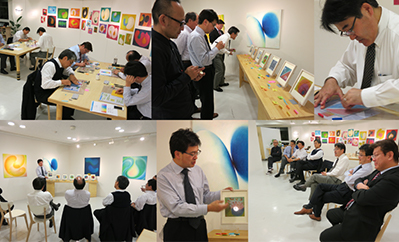
Koshiba: JSR started out a synthetic rubber business. Over the years based on the corporate philosophy of “Materials Innovation”– namely, “creating value through materials” - we’ve grown the business by expanding the core synthetic rubber business into new areas. However, the nature of the materials business is such that the scale of each business is modest. Our business is about slowly developing lots of small products, and incubating them to become businesses with revenues in the tens of billions of yen. And we’ve actually been pretty successful in doing this.
The six who took part in this program with me became directors at a young age, and have a strong sense of accomplishment. They tend to pursue goals directly. But if that’s all you’re doing, you’re never going to get any innovation happening.
Nakahara: What kind of people did you select for the Vision Voyage Program?
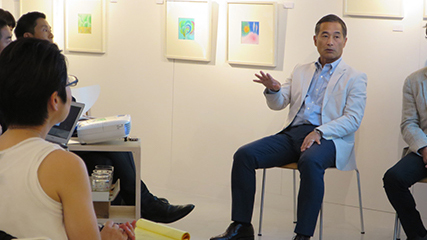
Koshiba: Our management team is relatively young, my colleagues as well as myself. They’re people who were elected to the board in their late 40s. The members I picked this time are the next generation of leaders - aged 47-51 and newly elected to the board.
Nakahara: Those you selected, did they approach this program extremely positively?
Koshiba: I’d say the reaction of the majority was, “Why do we have to do this?” But I was fine not having a purpose. I thought it was important not to seek a certain kind of outcome on the back of this exercise.
In order to build an organization that will continue innovating, I believe the next generation of leaders need to have the courage to push beyond their comfort zone and not be bound by their past successes. That’s why I wanted them to take up the challenge of doing something they’re completely useless at. To take up the challenge of doing something which has no visible outcome, and is devoid of any sense of accomplishment. In my mind that was the entire point.
Nakahara: As we mature and progress in our careers, I guess there are fewer opportunities to experience feeling out of place, a sense of discomfort.
Koshiba: That’s true if all you do is stick to what you do best. But when it comes to Materials Innovation, as a firm we can’t survive if we just stick to the existing business of car tires, semiconductors and LCD – we need to create new businesses. Think of it this way: it’s as if a kindergartener suddenly finds himself in graduate school – you have to jump into a totally new world. This means you have to meet new people, forge new connections, and gain new knowledge. But for those of us who’ve spent all this time building up what we have now, this makes us uncomfortable. Nevertheless it’s something we need to confront. Particularly for the younger members of the team, I really want them to face this challenge head on.
Nakahara: Now that the program has finished, what kind of changes have you noticed?
Koshiba: I guess it really depends on the person. It’s precisely because the act of painting a picture is in itself meaningless, I wanted each person to create their own meaning. The people I picked for this program are key people – they are future leaders. Of course they’re all skilled and competent, so in the final equation it’s a matter of readiness – it’s a matter of the heart. It’s a question of resolve. How far have they come along as leaders capable of spearheading innovation? I’m sure they’re there yet. That’s why I’m considering getting them to continue with this program, perhaps bringing on board a few additional people.

Talk2:
Shifting from Top-Down Thinking to Bottom-Up Thinking
Akio Yajima (Senior Fellow, The Japan Science and Technology Agency)
The adoption of EGAKU Program as part of the Vision Forest program, for the management team at Hitachi Systems, eventually led Yajima to enroll in the TOTSUKITOKA for his personal interest. During the course of the 10-month program, he noticed the change in his mindset and continued with the program for a second round, completing his 20-month painting experience in March.
Yajima: In the process of evaluating this program for our management team, I became fascinated by TOTSUKITOKA (a 10-month painting program for individuals) – I was eager to find out whether I’d change and how I might change. The first thing I noticed at the outset was that my mindset was “top-down.” I first conceived the theme in a logical manner, and then tried to figure out what colors and shapes to use to express these ideas through a process of trial and error. But the problem was, things never seemed to go as planned. Using a top-down approach didn't really work.
In the latter part of TOTSUKITOKA, I found myself adopting a more bottom-up thought process. Defining the meaning of the theme for myself, and painting simultaneously. At the same time, I started to develop what you could call my own authentic style of expression. I think that was a significant change.

However, at the end of the 10 months, I realized that unlike other participants most of the comments I wrote in the appreciation exercise didn’t go beyond the appearance of things. I felt that was something I wanted to change. The other thing I wanted to know was whether my style of expression would change if I painted the same themes again.
When I repeated the program the second time round, I felt that the two thought patterns “top-down” and “bottom-up” merged, and I felt that I was using both. By the time I approached my 20th painting, I had the feeling of being in a state of flow – this sense of being able to create and express myself in a free and relaxed manner. This is what I’ve called “fusion.”
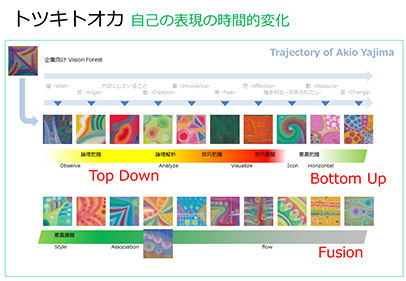
Here you can see my works displayed in chronological order, conceived in 3 dimensions there were two major stimuli that shaped them.

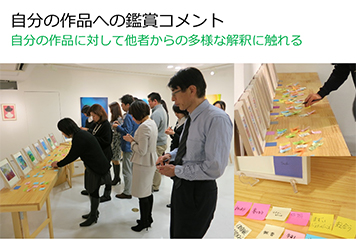
First, despite the fact we’re responding to the same theme, other participants approach painting with a completely different set of values and thinking. It was a rich experience to come into contact with so many diverse ways of seeing the world every time.
Second, the opportunity to hear the thoughts and comments on my work from other people who have diverse values, many of which I’d never think of myself.
At the end of the 10 months, reviewing the items listed in ”Who is this program for?” in the TOTSUKITOKA program overview, I was surprised. Everything listed there was consistent with my experience.
Through this intense experience over these 20 months, I sense I’ve managed to come close to the essence of TOTSUKITOKA.
It’s a “journey to discover your values (ICON) and the way you choose to lead your life (STYLE)”, at the same time it’s “a roadmap that helps you discover a new world of possibilities within your current way of living.”

I hope to use these insights I’ve gained through this process to continue challenging myself in various ways.

Talk 3:
Shifting from "Carrying our their Roles" to "Acting Autonomously"
Miho Kawasaki (Organization Learning Consultant, Globis Corporation)
In 2013 Miho Kawasaki completed her studies in Human Innovation at the Aoyama Gakuin University Graduate School of Social Informatics. In her masters thesis titled, “A Study into the Learning Process for Business People – the Impact of Repeated Participation in an Art Program”, she mapped out the learning process behind the EGAKU Program through a series of interviews with participants of the TOTSUKITOKA program. Kawasaki is currently enrolled in the TOTSUKITOKA program.
Kawasaki: As someone who’s been looking at Japanese firms during my 10 years working in HR at a construction company and subsequently in my role of designing corporate training programs, there’s one thing that’s troubled me. Everyone at these firms were serious, talented, had a strong sense of responsibility, but on the other hand it was hard to get a sense of liveliness, a sense of enjoyment. They dutifully carry out their “assigned roles” but it didn’t seem that their hearts were really in it. I basically felt that individuals had been buried in the corporate machine, and that their true potential hadn’t been fully realized in organizations. This question of how to transform the nature of work in organizations from one defined by roles and obligations, into one where individuals are engaged in work as “an activity that arises from within” has been on my mind for many years.
And so when I came across EGAKU Program a few years back, it occurred to me that the “TOTSUKITOKA” program whereby participants take part in a series of EGAKU Programs, might provide some clues to this – that’s how my research began.
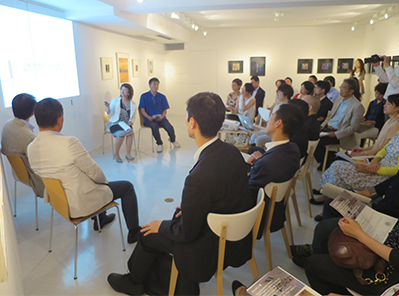
Two Surprising Shifts
The thing that surprised me the most in analyzing the learning process embedded in “TOTSUKITOKA”, based on my interviews with program participants, was the fact that I observed two major “shifts”.
The first was a “change in their behavior.” Namely, the kind of behavior that stems from the desire to “explore the new possibilities within yourself, and shape your life as you truly want it.” The other change I noticed was “a shift in their standards for making judgments and decisions” – from one based on “socially defined evaluation standards to internal evaluation standards.” Although this is all relatively speaking.
Uncovering a 3 Stage “Learning Process “
It’s not just Yajima who experienced the personal transformation he described, in fact other participants also underwent a similar transformation.
The business people who experience the EGAKU Program continuously, go through a 3 stage “learning process”:
“Doubts about Self-Expression are Swept Away” → “Art Learning Cycle”
→ “Connecting to the Every Day”

Step 1: Doubts about Self-Expression are Swept Away
I believe that as adults, as business people, we rarely get the chance to express what we’re feeling or talk about our values. It’s embarrassing and we’re concerned about what other people will think of us. It takes real courage to express your true self.
In the EGAKU Program, you find you can’t draw well, and so many things don't work out as planned. As a result there’s a tendency to feel disappointed and conflicted. But at the same time, you find you’re actually enjoying painting, you find yourself enjoying learning about what others are thinking and feeling through their pictures, and discovering the incredible diversity of human expression.
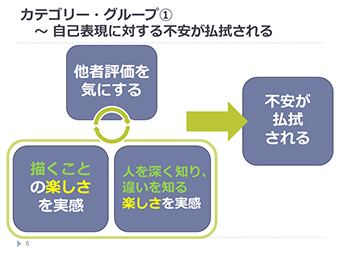
So as they oscillate between these mixed emotions, once they confirm that “I can express myself without worrying” and “it’s ok to say anything at all” – their doubts are swept away. This is something I found to be the case for all interviewees. In fact, for most people this change seems to occur around the third session, and then they enter the “artistic learning cycle”.
Step 2: Artistic Learning Cycle
It seems that once you enter the “artistic learning cycle” you enter a phase in which you physically experience different ways of seeing things, and different kinds of expression. Of course everyone knows in their minds, that they’re different from other people, but this when you viscerally understand this. And once you understand that you’re different, then you start thinking, “So it’s ok to be different!” That’s why next they shift to the way of thinking: “I want to explore my thoughts, my feelings even more!”
“What does joy mean to me?” “I wonder what sorrow means to me?” or perhaps “What is hope?” “And what is the meaning of joy for us human beings?” In this way, their thinking becomes focussed.
And then you start thinking, “I want to give this full expression,” “I want to let it all out.” You’re satisfied when you feel you managed to really give it all you’ve got. You think: “That felt really good.” It’s not about what others think, but whether you felt it was good becomes the standard of evaluation.
In the second half of the session, the thoughts and feelings expended by other participants are displayed as a few dozen paintings, and here again you have the opportunity to accept diversity. This process which is repeated over and over again is what I call the “art learning cycle.’”

One important feature of this process is that you keep making choices. The pictures are created through a series of decisions. Choosing one out of 12 different colored canvases, what color pastels you’re going to use, where to start painting, how far you’re going to pursue that train of thought, and when to finish. There are all these choices to be made, and unconsciously or consciously you make these choices. And when you’re done, you take a close look at your handiwork, - you’re forced to confront your decisions and take responsibility for what you’ve expressed, the choices you’ve made. I think repeating this process spurs “the shift from socially defined evaluation standards to internal evaluation standards.”
Step 3: Connecting to the Every Day
At the end of the day, what do participants get out of all this? And how does this connect with their daily lives outside the EGAKU experience?
At this point there was a notable difference depending on their motive - between those who participated of their own accord, and those who’d been sent by their employers. What was common for both groups was the heightened desire to “understand other people.” Their capacity to embrace diversity and appreciate diverse value systems was enhanced. On the other hand, something only observed in those who’d made the choice themselves, was the desire to pursue the new possibilities they discovered within themselves. A shift from thinking in terms of “either/or” - “either A or B” - to thinking in terms of “A and B” , “and”– a shift to a more holistic way of thinking, and when that happens the way you see the world changes. You start thinking in terms of next steps and possibilities, and thinking there must be something that lies ahead. You begin seeing new possibilities in yourself. That’s a significant transformation.
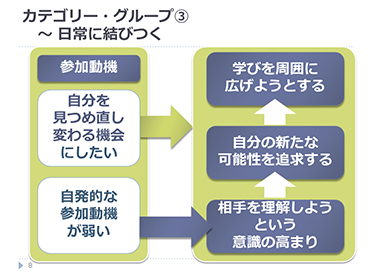
What’s happening is essentially what I mentioned earlier, the move to “explore the new possibilities within yourself, and shape your life as you truly want it.” Becoming aware of this kind of potential is something to delight in. People who’ve experienced this kind of transformation think, “I want to share this experience with others,” and they start to share this discovery with people around them.
Kawasaki herself enrolled in the TOTSUKITOKA program in February. Every time she attends a session she powerfully experiences “the raw voices of human beings” and the “true simple thoughts and feelings”, and feels that it’s an incredibly stimulating experience. As a human resources development professional Kawasaki also sees the potential of the EGAKU Program as “an opportunity for individuals to be transformed into people capable of realizing their potential within their organizations.” She sees the EGAKU Program as a “program that allows individuals to regain their vitality by helping them bring their internal compass into view” and as a “powerful tool enabling teams to realize their potential by laying the foundations for mutual understanding and respect for others.”

Concluding Remarks:
The Three Unsettling Effects of Art Hold the Key to Growth
Jun Nakahara (Associate Professor for Management Learning, The University of Tokyo)
In the context of art and adult learning – we’re always being told to “be more objective”, we’re rarely told to “be more subjective”. In the corporate world, in organizations “subjectivity” is regarded as a negative word. In some respects, being true to yourself, and expressing yourself subjectively is unusual behavior. So for some people it’s an unsettling act.
Secondly, from a young age, we’re all told to “(re-)charge,” to accumulate. But with art it’s all about “discharging”– showing your real nature. It’s also engaging in something removed from the every day. So when someone who’s been told “re-charge” all their lives is suddenly told to discharge, they’re bound to think, “Huh?!”
The third point is, we can’t seem to get out of the habit of making value judgments. Art makes us realize this, and forces us to think about this. I believe that once we get beyond thinking of things in terms of their relative merits – it sets the stage for significant growth.
In these 3 respects, this is an extremely unusual activity. Ultimately I think it boils down to this: Do you want to try something out of the ordinary? Although who knows what awaits you. (Laughter)
Postscript from the Editor:
So what lies in the wake of this unsettling effect of art?
“Being subjective” – thinking for yourself, creating your own meaning, and giving it expression.
“Showing your true nature” - it’s not about accumulating knowledge and facts, but about giving expression to your true self.
“Going beyond judging things in terms of their relative merits” – it’s not about making relative evaluations, but about confronting problems that don’t have answers.
All of these are qualities that will be sought in leaders who will be at the vanguard of the future. In fact, the thoughts shared by the speakers from their 3 different viewpoints, seemed to suggest that this trend for the future is already underway.
Having said this, with the elusive world of art, once you’ve figured it all out perhaps it’s no longer art. As we explored the meaning of EGAKU through this talk session, I feel that the contours of “What EGAKU gives” started to emerge. Our deepest thanks to the moderator, Professor Nakahara and our speakers – Mr. Koshiba, Mr. Yajima, Ms. Kawasaki – and everyone who joined us.